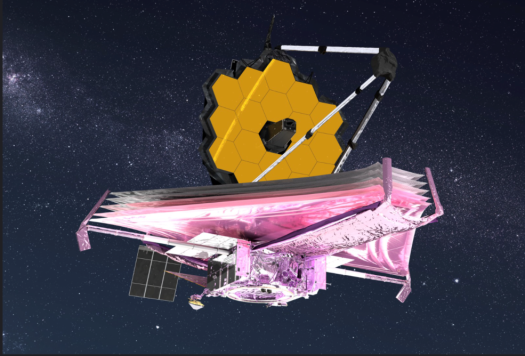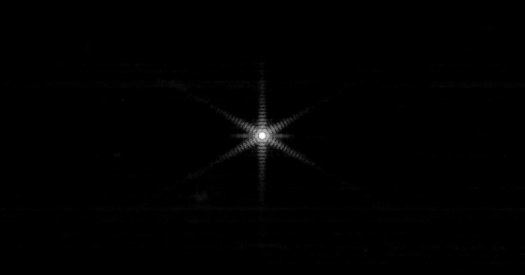
The last time Many Worlds wrote about the James Webb Space Telescope, it was in the process of going through a high-stakes, super-complicated unfurling. About 50 autonomous deployments needed to occur after launch to set up the huge system, with 344 potential single point failures to overcome–individual steps that had to work for the mission to be a success.
That process finished a while back and now the pioneering observatory is going through a series of alignment and calibration tests, working with the images coming in from the 18 telescope segments to produce one singular image.
According to the Space Telescope Science Institute, working images from JWST will start to appear in late June, though there may be some integrated “first light” images slightly earlier.
Exciting times for sure as the observatory begins its study of the earliest times in the universe, how the first stars and galaxies formed, and providing a whole new level of precision exploration of exoplanets.
Adding to the very good news that the JWST successfully performed all the 344 necessary steps to unfurl and that the mirror calibration is now going well is this: The launch itself went off almost exactly according to plan. This means that the observatory now has much more fuel on hand than it would have had if the launch was problematic. That extra fuel means a longer life for the observatory.

Before launch, the telescope was expected to last for five years. Now NASA has said fuel is available for a ten year mission and perhaps longer. Quite a start.
(A NASA update on alignment and calibration will be given on Wednesday. More information about it is here.
Because this column focuses on astrobiology (the search for life beyond Earth) and exoplanets, we’ll for now leave to others the spectacular astrophysics and cosmology to come and focus on the JWST and exoplanets.
As reported earlier, the observatory was first planned before any exoplanets had been discovered and was for a long time not an exoplanet mission at all. But as the number of planets in other solar systems began to really grow after 2000, capabilities were added to provide some exoplanet observing. And since the JWST mirror is so much larger than any before it, those capabilities came with much, much higher resolution and “seeing.”
The result is an infrared observatory that will super-speed exoplanet science in the years and decades ahead, and this column will delve into the JWST Early Release Science Program, which will allow some results and insights into how to use the telescope to come out within months of the telescope’ commencement of science operations or “first light.” A look at some of the scores of exoplanet projects on tap for just the first year of JWST operations will come in a second column.
The overall goals of the JWST exoplanet program include detecting particular molecules in the atmospheres of planets that transit in front of their host stars; to understand more about the wild diversity of exoplanets and solar systems; to get a better handle on why they are so different; and to focus on some of the solar systems that seem most promising for habitability.
As you might imagine, there are many observations planned of the seven rocky planets orbiting the nearby TRAPPIST-1 star, several of which are in what is considered to be the solar system’s habitable zone.

Astronomers, planetary scientists, astrobiologists and others have been planning for several years for the moment when JWST begins actual observations of exoplanets. A key part of that preparation was the creation of an Early Release Science Program, which would focus on well-known targets and both learn about them and learn for the community at large some of the strengths and complexities of how the observatory works.
The program was developed when the JWST was expected to operate for 5 years rather than 10, and so it was deemed essential that the broad community of potential observers have the opportunity to quickly learn what the telescope could and couldn’t do.
That broad community consists of scientists involved with “transmission spectroscopy.” The science of exoplanet transits initially focused on discovering planets by way of finding stars which experience periodic and detectable dimmings of light that are caused by a planet passing in front of them. JWST allows the science to take a big step forward by taking far more detailed measurements that can tell scientists if an atmosphere is present around a transiting exoplanet and if so what chemicals might be in it (as determined through spectroscopy.)

The Nexus for Exoplanet System Science (NExSS), an interdisciplinary initiative of NASA’s Astrobiology Program (and sponsor of this column), was one of the user groups that played a significant role in advocating for and establishing the Early Release Science Program. It had also been proposed by the JWST Advisory Committee of the Space Telescope Science Institute (STScI), which manages for NASA operations and observing schedules for space telescopes.
In a public meeting convened in 2015 by Kevin Stevenson, an astronomer with the John Hopkins University’s Applied Physics Lab who was then at the University of Chicago, the early release program was fleshed out and spurred on. Instrumental in the early effort were astrobiologiost Natalie Batalha of University of California, Santa Cruz , astrophysicist Nikole Lewis of Cornell University and astrophysicist Jacob Bean of the University of Chicago.
The consensus view of the many exoplanet scientists involved, Stevenson said, was that the Early Release Program should involve observations using four of the Webb main instruments, that it should include proposals using the three main methods of observing transiting exoplanets and their atmospheres, and that the planetary targets should be large and well studied.
“The goal is to give scientists access to Webb data as early as possible so they can develop observing proposals informed by our early experiences with the observatory,” Stevenson said. “And, of course, many of the early observations will produce data that will call out for follow-up observations.”
Some of that early data will be made available to the general community before it is even analyzed by the group that collected it.
“Whether it’s 5 years or 10 years, the Webb has a finite lifetime,” Batalha said. “It won’t be like the Hubble, which has been observing now for 30 years. So we wanted to hit the ground running,”
Batalha is now Principal Investigator of the Early Release program and Stevenson and Bean are co-Principal Investigators. Scores of other exoplanet scientists are co-investigators on the project.

The targets of the program are all hot Jupiter planets, and all have been pretty well studied previously from the ground and from space. As Stevenson explained, hot Jupiters are large and move quickly around their host stars, making them relatively easy to observe. In addition, their hot atmospheres makes them easier to study in terms of their chemical make-up.

But while scientists know a lot about them, these hot Jupiters have never been observed in the wavelengths and with the precision that the Webb will allow.
As an infrared telescope, the JWST will be able to detect molecules that cannot be found using telescopes with previously-used wavelength regimes. And this can lead to exciting new science, as well as a producing that guidebook on how to use the new telescope.
But to step back a minute: Hot Jupiters get their name because of their large size and gaseous composition (like Jupiter) and their unusually close location to their host stars. Large gaseous planets are believed to be formed in frigid temperatures, and in our solar system that means formation must occur beyond the asteroid belt, far from the heat of a Sun.
Yet mysteriously these hot Jupiters in faraway solar systems orbit significantly closer to their host stars than Mercury orbits our Sun. This leaves astronomers understandably eager to understand just how these hot giants got there.
As explained by Batalha, one way to learn more about the origins of hot Jupiters is to determine the ratio of carbon (as carbon dioxide, methane and other compounds) to oxygen (as in water vapor, carbon monoxide and more) in the planet’s atmosphere.
This ratio can be used to help scientists understand where in the original planet-forming disk the hot Jupiter actually came together and thus how much — and when in its history — it migrated inward. The Webb, Batalha said, will allow scientists to make those ratios far more precise.
This is just one of many, many exoplanet mysteries that will be studied and perhaps solved with the Webb.

The Early Release Science Program is one of three avenues for exoplanet scientists to win observing time on the Webb. There is substantial time allocated to scientists who contributed to the development of the telescope and its instruments, and also many Cycle 1 hours for scientists who proposed observations and were selected out of the many hundreds who applied.
Many Worlds will look at some of those other efforts in the next column.
Both Stevenson and Batalha lead or participate in teams selected through these other two observing programs and are beyond excited about the possibilities.
With all the delays related to the cutting edge technologies and procedures needed to make the telescope perform as desired (the Webb was in development for more than 20 years) Stevenson said that he has been looking forward to this moment since he was a post doc, more than a decade.
“This is going to revolutionize exoplanets — what we know about their atmospheres, their formation, their compositions,” he said. “It’s just so cool.”

3 Replies to “The James Webb Space Telescope And Its Exoplanet Mission (Part 1)”
Comments are closed.